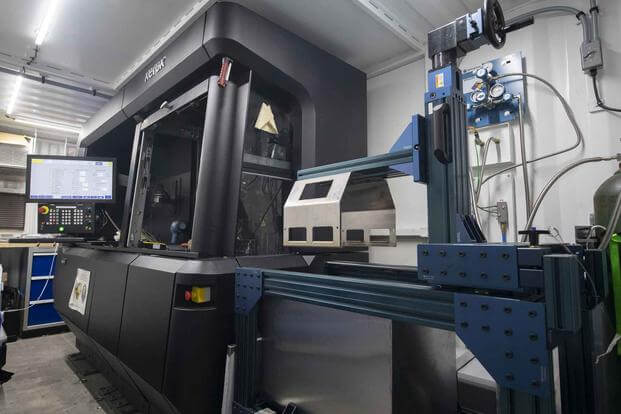

At this year’s Exercise Rim of the Pacific, the U.S. military is putting a major emphasis on logistics and new technology as it looks at operations across the Pacific. One technology that’s getting special attention is 3D printers, a rapidly evolving technology that uses computers and manufacturing equipment to quickly build tools and components to machines—in this case, military vehicles and weapons systems.
As the military looks at vulnerable supply chains and struggling manufacturing hubs, 3D printers are an appealing tool to commanders.
“This is the largest exercise of this type that has been conducted, ” said U.S. Marine Chief Warrant Officer Matt Pine, who specializes in military capabilities for the technology. “We’ve been working at Camp Pendleton aggressively getting out into exercises, taking our capabilities out, showcasing it through the fleet.”
The 3D printing aspect of RIMPAC is being put together in part by FleetWerx, a technology and strategy initiative associated with the Naval Postgraduate School in Monterey, Calif.
“The whole goal of what we’re doing here is for all the services, the Coast Guard, the Marine Corps, the Army, ” said Patrick Tucker, a contractor with FleetWerx. “We’re trying to bring together advanced manufacturing in one exercise. It’s aspirational, but I think we’re advancing with it.”
For the exercise, a series of 3D printers are both on land and at sea, with a printer aboard the warship USS Somerset. Military planners envision a “network of printers ” put in key locations to help troops and commanders more quickly get critical parts in the field. Pine said senior leaders at the NPS told him that they “want to see how big we can go and how fast.”
An important part of that is ensuring that they’re big enough to make quality parts while also small enough to transport. Tucker showed reporters a series of 3D printers that were built into modified shipping containers and presently operating at Marine Corps Base Hawaii in Kaneohe. They are expected to move by truck to different locations during the exercise.
The prospect of placing them on or near battlefields poses challenges. The sort of 3D printers they’re working with are expensive and hard to replace. But Tucker said that if they’re protected by troops, they can stay relatively safe.
Tensions have been on the rise in the Pacific as China finds itself embroiled in a series of territorial disputes with neighboring countries over maritime territorial and navigation rights. In June, members of the Chinese coast guard rammed and boarded Philippine navy boats that were resupplying an outpost in disputed territory, resulting in one Philippine navy sailor losing a finger during the altercation.
The Chinese military has been stepping up operations around the Philippines and around Taiwan—a self-ruled island democracy that Beijing considers a rogue province. Meanwhile, the U.S. military has conducted near-constant “freedom of navigation ” operations in the area over China’s objections. Though diplomats have worked to cool tensions, analysts worry about the prospect of a major Pacific conflict breaking out. U.S. military leaders are looking to all tools it could use in that event.
At RIMPAC the U.S. military is pushing 3D printing technology further than it has before, according to officials overseeing the exercise. Pine said, “The scaling is exponentially higher than anything that we’ve ever worked before. And having all of these other units available as resources gives us a global reach in global logistics issues.”
The containers at MCBH are products of Spee3D, an Australian company. These printers have seen real-world use in the war in Ukraine, where they have been used to rapidly make highly in-demand parts for armored vehicles and weapon systems that Ukrainian forces rely on to hold the line against invading Russian forces.
Tucker said that when it comes to the U.S. defense industrial base, “in some areas it’s very healthy ; in others it’s very weak. Sometimes where it’s very weak is actually some of the more important weapon systems that we have.”
Russian drone and artillery strikes frequently disrupt supply lines. But by being able to build spare parts near the front line, Ukrainian forces are able to compensate for that. Tucker said, “The biggest thing this is trying to get after is not to have to do back-and-forth between the contested zone, if you can at least limit it.”
Military leaders are mindful of that in the context of the vast expanse of the Pacific. Strategists often bemoan the “tyranny of distance ”—the challenges of both moving troops across the large region while also keeping them supplied with the weapons, fuel, water, food and spare parts they need to keep operating.
The rapidly evolving capabilities that 3D printing offers are potentially game-changing. But Tucker cautions that while it can help troops with supply-line troubles, it doesn’t solve them outright.
“It’s going to chew on the problem ; it’s not going to completely change the problem because (of ) the pace that we need parts, and machines don’t keep up with that, ” Tucker said.
___
(c)2024 The Honolulu Star-Advertiser
Visit The Honolulu Star-Advertiser at www.staradvertiser.com
Distributed by Tribune Content Agency, LLC.
© Copyright 2024 The Honolulu Star-Advertiser. All rights reserved. This material may not be published, broadcast, rewritten or redistributed.
